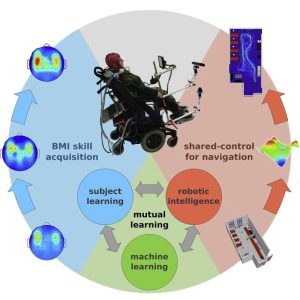1. One thing that helps
An international team of researchers has developed a mind-controlled wheelchair for tetraplegics. People paralysed from the shoulders down can move their wheelchairs around with 95-98% accuracy using just their brain. The trialists wear an electrode covered-cap (as in an EEG) and their brain signals are interpreted by AI and translated into movement. The key in this project is that no invasive brain implant is needed.

The participants had to undergo training in order to use the wheelchairs. That means learning how to work with AI. People had to visualize the wheelchair as moving while the AI interpreted their brain signals, which, in turn, caused the wheelchair to move successfully around a hospital obstacle course. The most successful participants were those who learnt to work with the AI. This partnership between human and machine saw not only the AI learning and improving but the human’s brain activity changing. This increased activity and stimulation could likely result in further benefits to the longevity of the brain.
2. One to be wary of
Wold you pay to see a movie with an AI generated version of your favourite actor?
The recent huge leaps in AI have seen AI move from drawing an image to now making a video out of a simple text prompt. When this tech matures, the entertainment industry will surely be shaken. The primary issue will be about copyright and actors ownership of their own likeness. Then there’s the issue of security and how these tools will be used.
While this software has security features that prevent their use for violent or sexually explicit material – coders have already bypassed them. In fact, the threat is so serious that Daniel Jeffries, chief information officer of Stability.AI, says, “We’ve heard from regulators and the general public that we need to focus more strongly on security to ensure that we’re taking all the steps possible to make sure people don’t use Stable Diffusion ( a text-to-image model) for illegal purposes or hurting people.” Attempting to regulate this seems like an impossible task so it is up to the tech community to prevent, identify and report misuse of this new capability.
3. One to amaze

This turtle isn’t teenage, a mutant, or even a ninja, but it wants to help the world in its own little way.
ART (Amphibious Robotic Turtle) combines the abilities of a turtle and a tortoise. It can walk on land and swim in the water. Its specialized limbs can adapt to the environment, thanks to variable stiffness and artificial muscles. Its legs can transform into flippers when going from land to water. How cool is that? Its design allows it to morph using less energy than other amphibious robots that traditionally have different propulsion systems for different kinds of terrain.
Our robot turtle friend can be used in research environments that include varying terrain such as shorelines and marshes. It can also be deployed in ocean farms where it can monitor farm conditions. Due to its adaptability, it can also be used to study complex surf zones with tides, waves and currents. And of course, wouldn’t it be nice to have it follow you as you dive in the ocean to fend off sharks and save you from drowning?